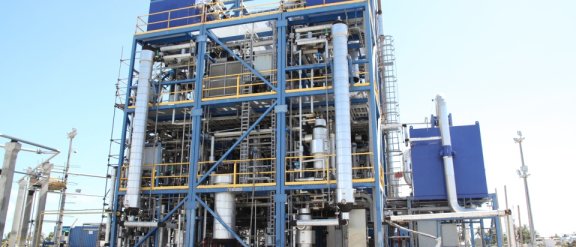Overview
Project type: GTL Commercial Demonstration
Customer: CompactGTL (For Petrobras)
Location: Brazil
Challenge
Gas to Liquids technology as a means of monetising stranded gas has been researched for many years and indeed there are some limited commercial applications onshore in specific niche markets.
CompactGTL has been developing GTL technology since 2000. The technology is differentiated by the use of a compact mini-channelreactor configuration that is employed both in the steam reforming and Fischer Tropsch steps. The reactor channel configuration and catalyst were developed in the laboratory at the proof of concept scale and in commercial length single and multi-channel reactors.
The specific niche for this technology is for oil associated gas in small volumes which might traditionally be flared or re-injected. The next step for CompactGTL was to test an integrated pilot scale facility (~0.1 bbl/day) in the UK and subsequently a planned commercial demonstration plant (in a joint testing agreement with Petrobras) designed to operate at 20bbl/day.
The demonstration plant was initially to be tested at an onshore facility in Brazil. The commercial application for Petrobras would ultimately be offshore on an FPSO.
Genesis was contracted to assist in developing the pilot plant design for multiple onerous requirements.
Understanding
The challenges for Genesis were:
Understanding how to scale up to demonstration plant scale;
Developing the utilities support required for such a facility and the interfaces with the existing onshore plant;
Demonstrating the correct integration of subsystems whilst keeping the overall system simple, easy to operate and robust for trials;
Optimising the plant parameters to maximise integration for efficient large scale to improve economics.
Solution
Genesis worked alongside CompactGTL to implement a series of generic process improvements that enabled: more efficient use of subsystems; flexibility to throughput and gas feed composition; equipment selection that took account of the very onerous materials requirements due to the presence of hydrogen and carbon monoxide and took full account of the safety implications on both layout and monitoring.
The design had to balance the requirements of the standalone nature of the demonstration plant (for less dependency on existing plant utilities and improved testing uptime) against the integration of subsystems required to reduce the costs for commercial scale plants and yet demonstrate and prove up the process.
In parallel, pilot plant EPIC Contractors as well as key equipment vendors were engaged and selected through market surveys. Tender documents were compiled to support this selection process with the FEED documentation package including the design basis, the process design package, plant configuration, equipment specifications, philosophies and cost estimates. The cost estimates developed had to ensure that the demonstration plant budgets and schedules could be met.
Project management support to CompactGTL continued during the execution of the EPIC contract.
Results
A commercial demonstration plant package was designed to meet the requirements of commercial scale up. It was designed in several skids allowing easy transportation to site.
In January 2012 CompactGTL announced the successful conclusion of the facility testing by Petrobras. At the same time the technology was approved by Petrobras as ready for commercial deployment.
Genesis has also assisted CompactGTL in the scale up of the facilities and commercial application to a number of offshore and onshore potential field developments.
